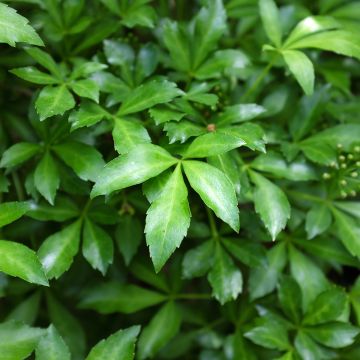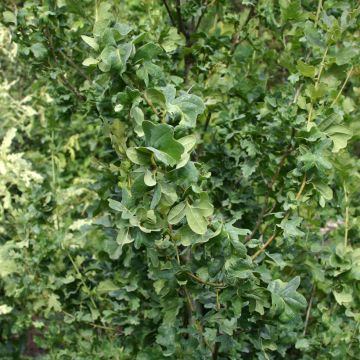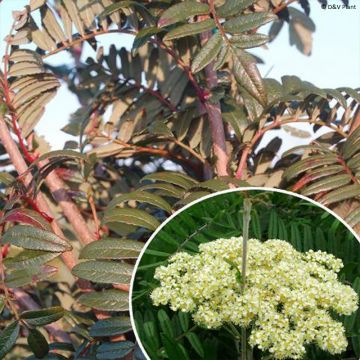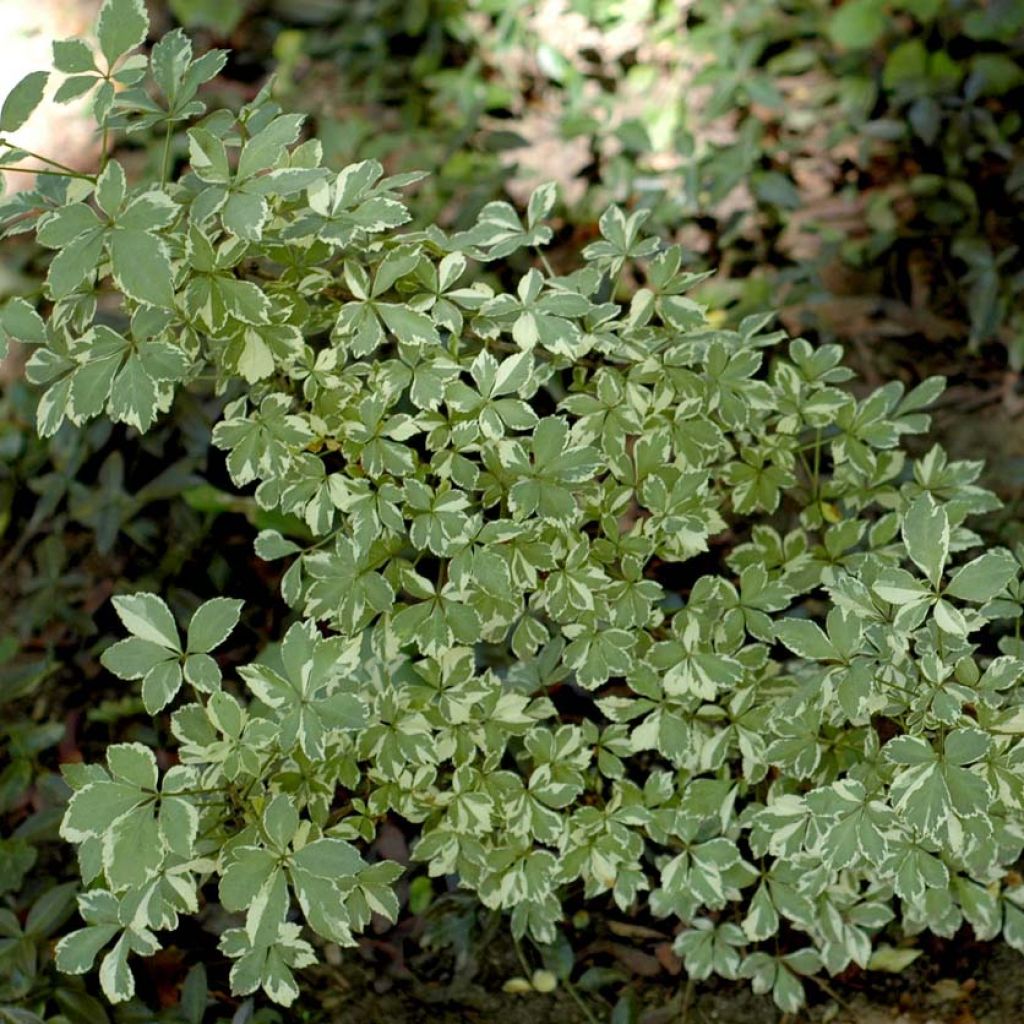

Acanthopanax sieboldianus Variegatus
Acanthopanax sieboldianus Variegatus
Acanthopanax sieboldii Variegatus
This plant carries a 24 months recovery warranty
More information
We guarantee the quality of our plants for a full growing cycle, and will replace at our expense any plant that fails to recover under normal climatic and planting conditions.
From €5.90 for pickup delivery and €6.90 for home delivery
Express home delivery from €8.90.
From €5.90 for pickup delivery and €6.90 for home delivery
Express home delivery from €8.90.
Does this plant fit my garden?
Set up your Plantfit profile →
Description
The Variegated Acanthopanax sieboldii, also called Eleutherococcus sieboldianus, is a lesser-known cousin of Japanese Aralias. It is a very cold-resistant Asian bush with a beautiful variegated foliage, and adapts to almost all growing conditions. It can be pruned and mowed if it grows too large. Its spring flowering is light and insignificant, but this bush is interesting for its palmate foliage margined with white-cream and remarkable in shade. It is perfect for adding a touch of light to dark areas of the garden, for example, under large trees or near a north-facing wall.
The Variegated Acanthopanax sieboldianus belongs to the Araliaceae family, just like ivy and tree angelica. This shrub is native to forests in China. Escaped from gardens in Japan, it has naturalized on limestone soils. Its cold resistance, below -15°C (5°F), allows it to be cultivated in all climates. While it prefers moist soils, it adapts to dry soils once well established, in summary, it only dislikes waterlogged soils. Acidic or clay soils also suit it very well. Urban pollution is well tolerated. It only dislikes scorching situations.
'Variegatus' is a highly ornamental form of this botanical species, which is distinguished by its more modest growth, its variegated foliage, and its excellent tolerance to dry shade. Still little known it should quickly find a place in our gardens. The slow-growing bush will reach an average size of 2m (6.5ft) in all directions. It may produce suckers that need to be eliminated to limit its growth or if their leaves do not have variegation. Its habit is bushy, both dense and elegant, supported by thin, arched, light grey branches. The deciduous leaves appear in spring and fall in autumn, quite late. They are grouped in 3 to 5 and attached to the branch by long green petioles. They are divided into 5 ovate leaflets, 3 to 6cm (1.2 - 2.4in) long, with a pointed tip, strongly dentate on the edges. They are randomly margined and splashed with white cream on a tender green-grey background. At the base of the leaf petioles, at the nodes on the branch, small curved and sharp spines are hidden. In this Acanthopanax, there are male and female individuals. Flowering occurs in June, earlier or later depending on the climate, in the form of clusters of small pale greenish-yellow flowers, which bring a touch of lightness to the plant. Female plants will bear small ovoid fruits that are black and quite decorative.
This Variegated Eleutherococcus sieboldianus forms a particularly bright mass, extremely decorative in all shady areas of the garden. It will thrive under trees where it can spread over time, on the edge of a grove, or near a wide path exposed to the east or north or associated with other shrubs. As it tolerates pruning well, it can perfectly be integrated into a loose or trimmed hedge, defensive or not. Mix it, for example, with hawthorns, Amelanchier spicata, botanical roses, white or pink spireas, or with hedge honeysuckles (Lonicera xylosteum) or winter honeysuckles (Lonicera fragrantissima). It is suitable for a naturalistic garden, English, Japanese, or even exotic style, and adapts from north to south and from east to west.
Report an error about the product description
Acanthopanax sieboldianus Variegatus in pictures
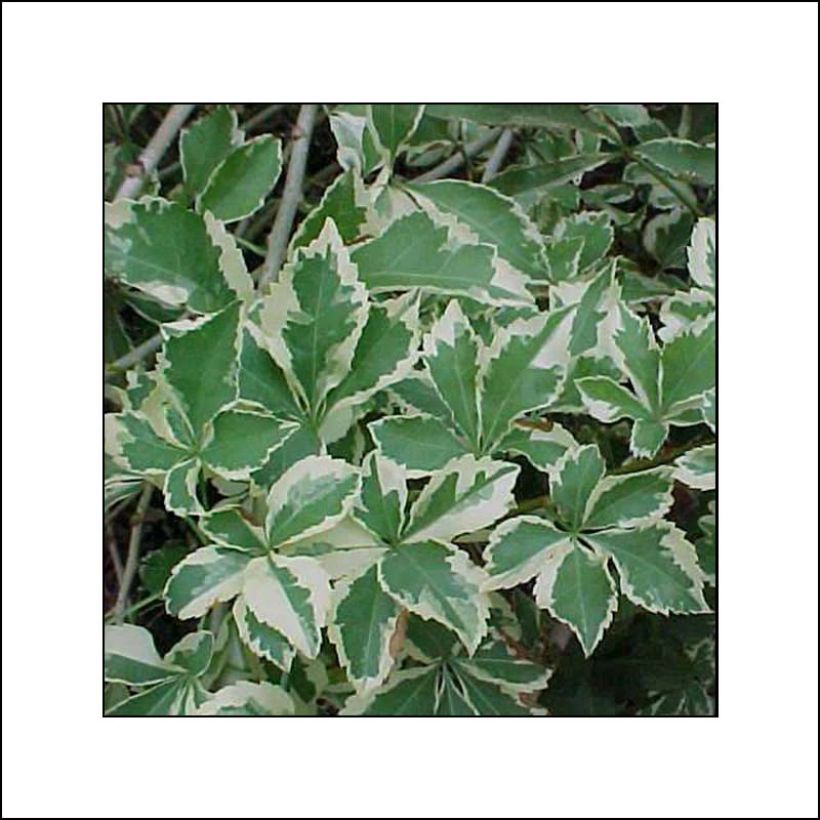

Plant habit
Flowering
Foliage
Botanical data
Acanthopanax
sieboldii
Variegatus
Araliaceae
Eleutherococcus sieboldianus, Acanthopanax pentaphyllus
China
Other Eleuthero - Acanthopanax
Planting and care
The Acanthopanax sieboldi Variegatus can be grown in open ground because it is hardy. It can be planted in spring or autumn, in any garden soil without excessive moisture. Once well established, it tolerates dry soils in summer, although it is more lush in soil that remains slightly moist. Limestone is well tolerated, this is a plant that has few requirements in terms of soil and exposure: only waterlogged soils or excessively hot situations should be avoided. Choose a semi-shaded exposure, in the morning sun, or even shaded. However, care must be taken to protect it from strong or drying winds to preserve its highly ornamental foliage. Monitor the appearance of branches or suckers whose adult leaves do not show variegation, and remove them. Troublesome suckers should also be removed, unless you want this plant to colonize an undergrowth where nothing else grows. You can prune this bush to encourage branching and limit its size. A severe rejuvenation pruning is also recommended every 4 or 5 years in late winter.
Planting period
Intended location
Care
This item has not been reviewed yet - be the first to leave a review about it.
Striking foliage shrubs
Haven't found what you were looking for?
Hardiness is the lowest winter temperature a plant can endure without suffering serious damage or even dying. However, hardiness is affected by location (a sheltered area, such as a patio), protection (winter cover) and soil type (hardiness is improved by well-drained soil).

Photo Sharing Terms & Conditions
In order to encourage gardeners to interact and share their experiences, Promesse de fleurs offers various media enabling content to be uploaded onto its Site - in particular via the ‘Photo sharing’ module.
The User agrees to refrain from:
- Posting any content that is illegal, prejudicial, insulting, racist, inciteful to hatred, revisionist, contrary to public decency, that infringes on privacy or on the privacy rights of third parties, in particular the publicity rights of persons and goods, intellectual property rights, or the right to privacy.
- Submitting content on behalf of a third party;
- Impersonate the identity of a third party and/or publish any personal information about a third party;
In general, the User undertakes to refrain from any unethical behaviour.
All Content (in particular text, comments, files, images, photos, videos, creative works, etc.), which may be subject to property or intellectual property rights, image or other private rights, shall remain the property of the User, subject to the limited rights granted by the terms of the licence granted by Promesse de fleurs as stated below. Users are at liberty to publish or not to publish such Content on the Site, notably via the ‘Photo Sharing’ facility, and accept that this Content shall be made public and freely accessible, notably on the Internet.
Users further acknowledge, undertake to have ,and guarantee that they hold all necessary rights and permissions to publish such material on the Site, in particular with regard to the legislation in force pertaining to any privacy, property, intellectual property, image, or contractual rights, or rights of any other nature. By publishing such Content on the Site, Users acknowledge accepting full liability as publishers of the Content within the meaning of the law, and grant Promesse de fleurs, free of charge, an inclusive, worldwide licence for the said Content for the entire duration of its publication, including all reproduction, representation, up/downloading, displaying, performing, transmission, and storage rights.
Users also grant permission for their name to be linked to the Content and accept that this link may not always be made available.
By engaging in posting material, Users consent to their Content becoming automatically accessible on the Internet, in particular on other sites and/or blogs and/or web pages of the Promesse de fleurs site, including in particular social pages and the Promesse de fleurs catalogue.
Users may secure the removal of entrusted content free of charge by issuing a simple request via our contact form.
The flowering period indicated on our website applies to countries and regions located in USDA zone 8 (France, the United Kingdom, Ireland, the Netherlands, etc.)
It will vary according to where you live:
- In zones 9 to 10 (Italy, Spain, Greece, etc.), flowering will occur about 2 to 4 weeks earlier.
- In zones 6 to 7 (Germany, Poland, Slovenia, and lower mountainous regions), flowering will be delayed by 2 to 3 weeks.
- In zone 5 (Central Europe, Scandinavia), blooming will be delayed by 3 to 5 weeks.
In temperate climates, pruning of spring-flowering shrubs (forsythia, spireas, etc.) should be done just after flowering.
Pruning of summer-flowering shrubs (Indian Lilac, Perovskia, etc.) can be done in winter or spring.
In cold regions as well as with frost-sensitive plants, avoid pruning too early when severe frosts may still occur.
The planting period indicated on our website applies to countries and regions located in USDA zone 8 (France, United Kingdom, Ireland, Netherlands).
It will vary according to where you live:
- In Mediterranean zones (Marseille, Madrid, Milan, etc.), autumn and winter are the best planting periods.
- In continental zones (Strasbourg, Munich, Vienna, etc.), delay planting by 2 to 3 weeks in spring and bring it forward by 2 to 4 weeks in autumn.
- In mountainous regions (the Alps, Pyrenees, Carpathians, etc.), it is best to plant in late spring (May-June) or late summer (August-September).
The harvesting period indicated on our website applies to countries and regions in USDA zone 8 (France, England, Ireland, the Netherlands).
In colder areas (Scandinavia, Poland, Austria...) fruit and vegetable harvests are likely to be delayed by 3-4 weeks.
In warmer areas (Italy, Spain, Greece, etc.), harvesting will probably take place earlier, depending on weather conditions.
The sowing periods indicated on our website apply to countries and regions within USDA Zone 8 (France, UK, Ireland, Netherlands).
In colder areas (Scandinavia, Poland, Austria...), delay any outdoor sowing by 3-4 weeks, or sow under glass.
In warmer climes (Italy, Spain, Greece, etc.), bring outdoor sowing forward by a few weeks.

































